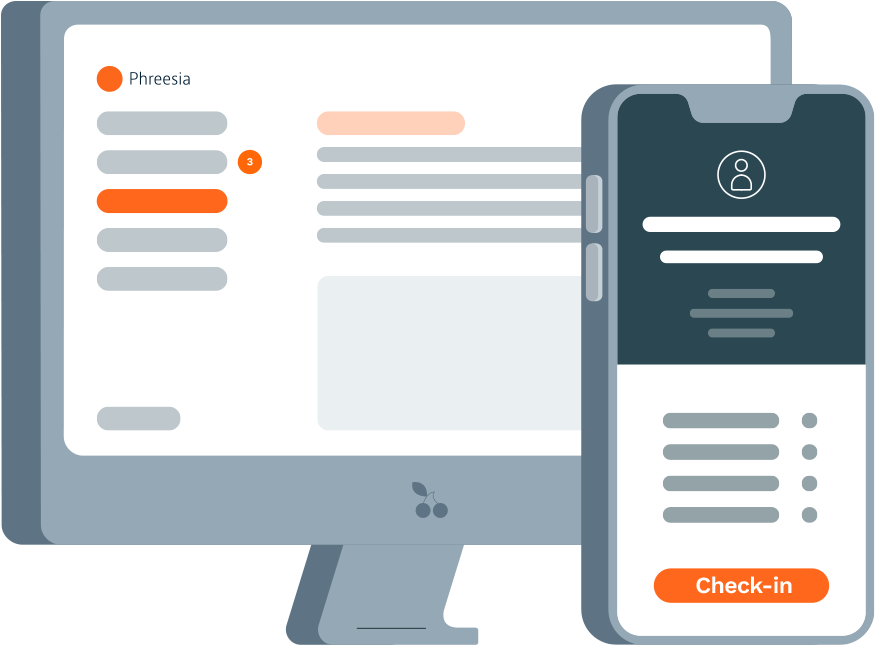Thinking about introducing new technologies to your patients? Wondering how to successfully implement a new product throughout your organization? If so, you’re not alone. Healthcare organizations are increasingly adopting new technologies to improve their quality and efficiency, and to enhance patients’ overall care experience. As an example, in 2018, 70% of respondents to an MGMA poll said they planned to adopt new technologies to make their medical practices more efficient, including automated patient check-in, telehealth and new or upgraded EMRs.
But how do patients feel about these changes? To find out, Phreesia Research surveyed nearly 5,000 patients across its network about how comfortable they felt using healthcare technologies such as mobile health apps, online portals and cost estimation tools. More than half of respondents said they approved of them, with 44% reporting that they already use technology to manage some aspects of their health.
While finding the right technologies for your organization’s goals, challenges and patient population is important, it’s only the first step. It’s equally if not more important to ensure that those new tools are successfully introduced to your patients. Consider these strategies and tips, informed by Phreesia Research data, to help your organization successfully introduce new technologies to your patients.
1. Make it easy.
First things first: When you introduce a new technology to patients, it should be high quality, fast and easy to use. Today’s patients expect technology that will streamline and enhance their healthcare experience, not cause more complications and confusion. It’s also important to choose transparent, easy-to-understand technologies so that practice staff don’t need to spend a substantial amount of time on patient education. They are already busy scheduling appointments, collecting payments and addressing greater patient concerns, so it’s vital to select technologies that don’t leave patients or staff frustrated and behind schedule.
Among those patients in Phreesia’s survey who said they were not comfortable using technology to manage their health, 30% said they would feel more comfortable if it was easier to use; 23% said they would like more instruction; and 19% said they would like more support. You can proactively address those needs by ensuring that your practice gives patients clear directions for using new technologies in laymen’s terms, and make sure staff is available to address questions or concerns.
2. Train your trainers.
With that staff oversight in mind, don’t leave planning and implementation solely in the hands of a few organization leaders, leaving out those who will actually use new technologies. Invest in a comprehensive employee training program to ensure that your staff has a solid understanding of new tech tools and is comfortable helping patients adopt them. Explain to your front-desk staff why a new technology is an improvement over current processes, highlighting benefits such as automating manual data entry and streamlining patient flow. Schedule adequate time for training and demonstrations, so that your staff can practice using the new tool, ask questions and review important safety and security protocols.
Is there someone in your office who is especially tech-savvy? Someone who’s especially well-liked by patients? Assign them as team leaders, and put them in charge of orienting the rest of the staff, as well as patients, to new technologies. Ask for volunteers to pilot new tools, and be sure that all physicians, nurses and practice managers who need to be familiar with those tools test them out as well. If your staff is comfortable and excited about using new technologies, chances are your patients will be, too.
3. Communicate the goals and benefits.
It’s important that patients understand not just what you are introducing, but why you are introducing it. Share the overall vision and goals with patients, providers and staff, and encourage them to spread the word. Plan some external communications about a new technology, including website, newsletter and social media announcements that highlight its value to patients. Studies show that perceived value, especially when it is linked to convenience and ease of use, can lead to successful mobile-health technology adoption, so be specific about wins of your new system. For example, explain how mobile check-in options save patients time in the waiting room, or how cost estimation tools can help them avoid surprise bills.
4. Make it mobile.
Today’s patients are accustomed to using technology that’s intuitive, user-friendly and convenient, like mobile technology. The vast majority of Americans own a cell phone and 93% of patients expect to use digital tools to interact with their providers. In a separate survey of more 10,000 patients, Phreesia asked patients if they liked using mobile messaging to communicate with their healthcare providers. Nearly 70% said yes, and within that majority, 43% said they preferred text messaging, followed by emails (37%) and online portals (25%). Consider introducing technology to patients that allows them to check in, update their clinical and demographic information and make payments from their mobile device. And don’t be hesitant to offer mobile options to older patients—they are also actively using mobile technology to manage their healthcare.
5. Make it personal.
In addition to convenience, it’s important to introduce technology to patients that’s customized and tailored to fit their individual needs. Email and text message appointment reminders allow you to send personalized and direct communications, while online payment plans and card-on-file options can be customized to fit patients’ financial needs. In addition, automated clinical screening tools, such as those that capture social determinants of health (SDOH) data, allow you to confidentially ask patients about personal health risks and other sensitive topics during the intake process, increasing the likelihood that they will share their concerns. This gives clinicians more information about a patient’s specific needs and allows for a more personal and productive clinical encounter. That capability is especially important given that nearly 30% of surveyed patients said they feared a loss of connection with their provider as new technologies become more common.
6. Make it secure.
Despite growing awareness and efforts to improve data security, the healthcare industry continues to be a prime target for data breaches. In 2018, the average cost of a healthcare data breach was $408 per medical record, the highest in any industry and three times the national average. So it’s no surprise that security is a prime concern for healthcare organizations, especially as it relates to implementing new technology. Patients worry, too. Some 35% of surveyed patients said security concerns were the main reason they did not feel comfortable using technology to manage their healthcare.
Healthcare organizations can protect themselves against those risks and confidently assure patients that their data is safe by making sure the technologies they implement comply with the highest security requirements, including HIPAA laws and data-encryption standards. You can also include this information on patient consent forms and in office signage as well. In addition, make sure third-party vendors are vigilant about safeguarding protected health information (PHI), conduct regular security-risk assessments and have a disaster recovery plan if a system outage occurs. Finally, seek out vendors that have received certifications or attestations of compliance against industry-recognized security standards, and point out those certifications when you introduce new technologies patients.
Learn more about how Phreesia’s Registration tools offer your patients a customized, convenient intake experience.




